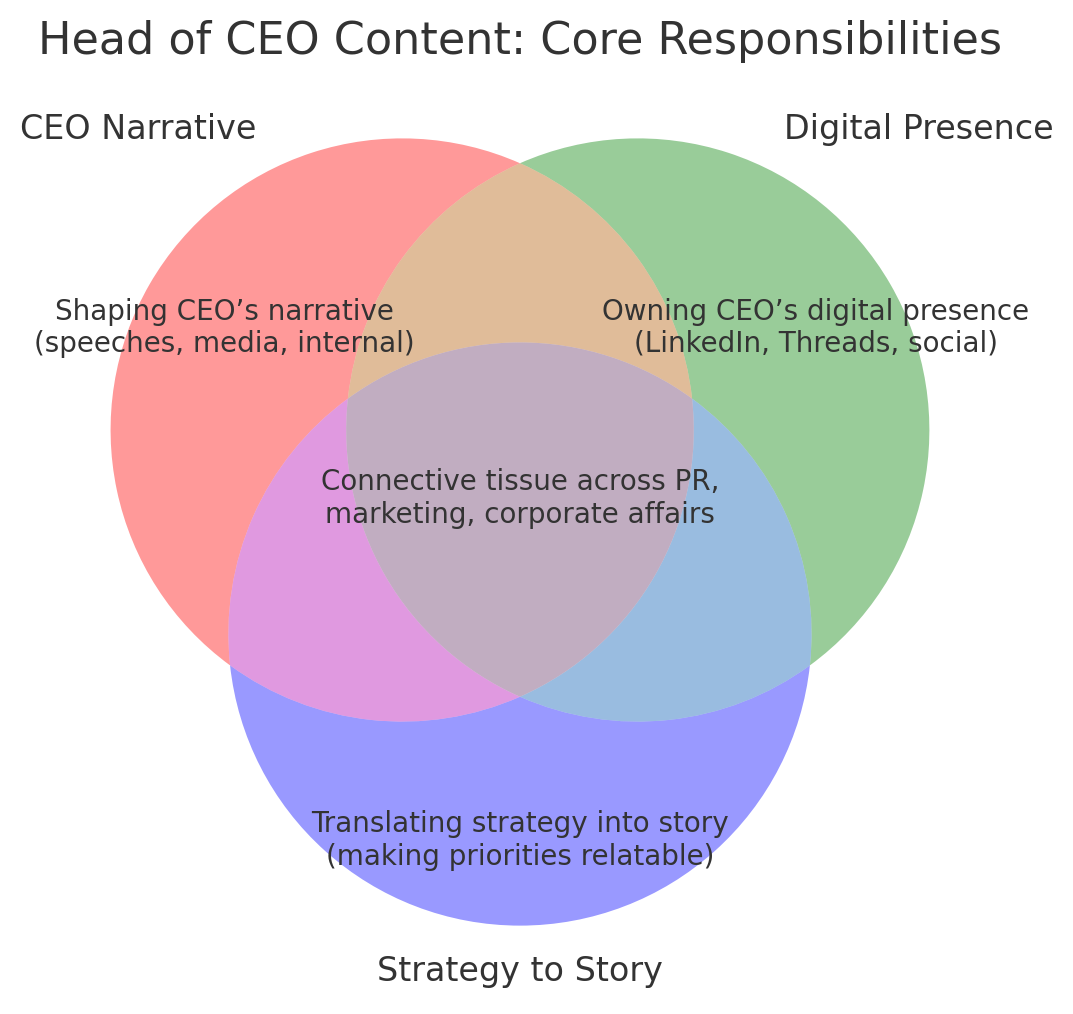What Head of CEO Content is and how marketers can step into the role
From ghostwriting to thought leadership, here’s what the job really is — and how you can position yourself for it.

A few weeks ago, PayPal quietly posted a job opening that says more about the future of marketing than their latest earnings call. The title? Head of CEO Content.
At first glance, it sounds unusual. Isn’t “content” something a brand or product team owns? Why would a global fintech giant need someone solely focused on a single person- the CEO?
From LinkedIn posts and keynote speeches to podcast appearances and internal memos, the CEO’s voice has become one of the most powerful marketing channels a company can invest in. And PayPal’s new role makes it official: executive visibility is no longer optional— it’s a strategy.
TL;DR
- PayPal just created a role called Head of CEO Content → a sign of where executive communications is headed.
- The job? Shape the CEO’s narrative, manage their social presence, and turn strategy into relatable stories.
- Why now?
- People trust leaders more than brands.
- Social platforms make CEOs direct communicators.
- Authentic voices cut through AI-generated noise.
- Strong CEO brands impact talent, market perception, and trust.
- Companies like Buffer also encourage employee advocacy to amplify reach.
- What it means for marketers:
- Skills needed → ghostwriting, thought leadership strategy, social fluency, stakeholder management.
- Build a portfolio → show before/after examples, engagement data, business impact.
- If you’re new → treat your own LinkedIn/Instagram as a case study to prove you can grow a personal brand.
- Bigger picture → “Head of CEO Content” may sound niche now, but it could soon be as common as “Social Media Manager.”
What the Role Actually Is
The title Head of CEO Content might sound like a fancy spin on PR, but it’s much more than that. It’s essentially a chief storyteller for the CEO— someone who ensures the leader’s voice, ideas, and presence are consistent, strategic, and impactful across every channel.
At PayPal, the responsibilities outlined go far beyond writing speeches or polishing memos. The role includes:
- Shaping the CEO’s narrative across thought leadership, media appearances, keynote talks, and internal communications.
- Owning the CEO’s digital presence on LinkedIn, Threads, and other platforms—developing content strategies, posts, and engagement tactics.
- Translating strategy into story by taking company priorities (like new product launches or cultural initiatives) and making them relatable through the CEO’s personal voice.
- Acting as the connective tissue between corporate affairs, PR, marketing, and the executive office, so that what the CEO says publicly aligns with business goals.

Why These Roles Are Emerging Now
PayPal hiring a Head of CEO Content isn’t an isolated event— it reflects a bigger shift in how companies think about influence, trust, and visibility.
- People trust leaders more than brands: Executives, especially CEOs, are often seen as more credible than the corporations they represent. In a time when institutional trust is falling, the human face of leadership matters more than the corporate logo.
- The rise of “social-first leadership”: Platforms like LinkedIn, Threads, and podcasts have turned CEOs into direct communicators. The old model of press releases feels outdated— leaders are now expected to show up online, authentically and consistently.
- Employee-driven advocacy adds momentum: Buffer is a great example. Instead of focusing only on the company’s brand accounts, they encourage employees to post actively on LinkedIn and Instagram, rewarding them for sharing authentic stories about their work and experiences. This not only boosts visibility but also builds credibility, because people trust employees more than polished brand campaigns.
- Market and talent impact: A CEO’s personal brand can drive business results. Leaders like Satya Nadella and Brian Chesky have shown how a strong, authentic voice attracts talent, engages investors, and strengthens market positioning.
- AI makes generic content invisible: With AI able to churn out endless generic content, what cuts through now is personal perspective. A CEO’s experiences, trade-offs, and decisions are unique— and that makes their content stand out.
- The competition for attention has evolved: Brands aren’t just competing on features anymore— they’re competing on narratives. In this battle for attention, a well-positioned CEO voice can become the ultimate differentiator.
How Marketers Can Step Into This Role
The title Head of CEO Content might sound like something reserved for elite executive comms professionals, but the reality is that many marketers already have the foundation for it. The key is knowing which skills to sharpen and how to position yourself.
1. Build the right skill set
- Executive ghostwriting: Learn how to capture someone else’s tone and voice in writing. Speeches, LinkedIn posts, op-eds, and internal memos are all part of the mix.
- Thought leadership strategy: Get comfortable turning abstract business goals into narratives that connect with audiences.
- Social media fluency: Know how to create content that actually works on LinkedIn, Instagram, or Threads—not just brand posts, but human-first storytelling.
- Stakeholder management: Be able to collaborate with executives, PR, marketing, and corporate affairs without losing sight of the bigger picture.
2. Create opportunities where you are
- Offer to ghostwrite or polish LinkedIn posts for your CEO, founder, or other senior leaders.
- Support executive comms for a big product launch, company town hall, or industry event.
- Partner with HR or comms to shape a thought leadership campaign that amplifies the leadership team.
3. Build a portfolio that proves impact
- Save examples that show how you improved clarity, consistency, or engagement for executive content.
- Track analytics on leadership posts: impressions, shares, comments, and growth in followers.
- Highlight business outcomes: Did a post attract inbound candidates? Did a keynote open doors for partnerships? That’s the proof executives care about.
4. If you’re new or don’t have direct experience
You don’t need permission to start. Treat your own social presence as a case study.
- Build a regular posting habit on LinkedIn, Instagram, or Threads.
- Share your perspective on industry trends, lessons learned, or behind-the-scenes process notes.
- Experiment with different content formats (text posts, carousels, video, threads) and see what resonates.
- Track and present your results—growth in followers, engagement rates, inbound opportunities—as evidence that you can build and manage a thought leadership brand.
This way, even without executive exposure, you can show that you understand the mechanics of digital storytelling, thought leadership, and brand building. And when the time comes, you’ll be able to point to your own presence as a proof-of-concept.
The Bigger Picture
“Head of CEO Content” may sound like a niche role today— but so did “Social Media Manager” in 2008. Back then, companies weren’t sure if they even needed someone dedicated to platforms like Facebook or Twitter. Now it’s one of the most common roles in marketing.
The same shift is happening with executive content. As trust in institutions declines and attention shifts to individuals, the CEO is becoming the company’s most important influencer. Their stories, their perspective, and their presence online shape how employees feel, how customers buy, and how markets respond.
For marketers, this is both a challenge and an opportunity. The challenge: generic content is no longer enough. The opportunity: there’s a growing demand for people who can craft narratives that blend strategy, authenticity, and influence.